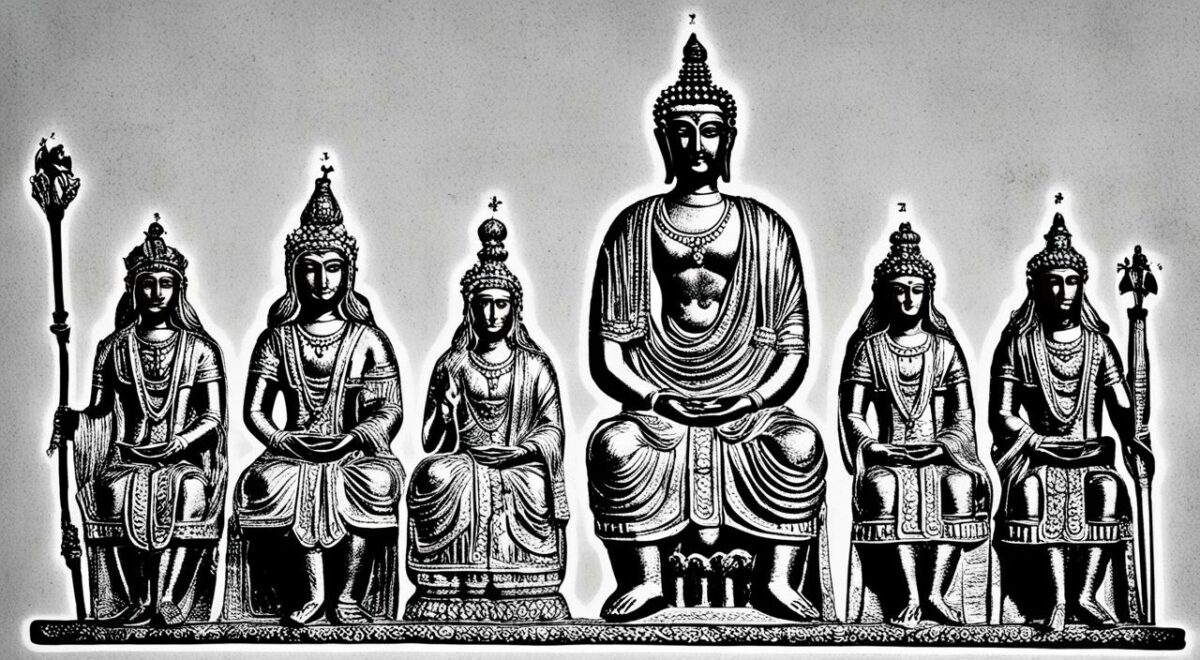Marriage customs are key to cultural identity. They shape how people connect and live together. There are two main types: endogamy and exogamy. Endogamy means marrying within your group, like the same race or faith. Exogamy means marrying outside your group.
These customs have been around for a long time. They still affect how we see diversity and unity today. They help keep cultural traditions alive. Knowing about endogamy and exogamy helps us understand marriage and family worldwide.
We will look into endogamy and exogamy’s history and how they work in different cultures. We’ll see their good and bad effects on people and groups. By looking at kinship, race, and faith, we’ll see how humans have dealt with marriage and keeping cultural identity.
Endogamy and the secretsof Sapinda marriage in
Defining Endogamy and Exogamy
What is Endogamy?
Endogamy means marrying within a group, like a social or ethnic group. It helps keep the family’s culture, values, and beliefs the same. This has been a big part of many cultures for a long time.
What is Exogamy?
Exogamy is when people marry outside their group. These marriages mix different cultures and genes. But, they can also bring challenges from cultural differences.
Many cultures still practice endogamy. It can lead to more genetic disorders from recessive genes. It might also make communities stick to their own kind, avoiding mixing with others.
On the other hand, exogamous marriages are becoming more common. People are choosing partners from different backgrounds.

Endogamy has been used to keep families close and traditions alive. But, it can also mean a smaller gene pool, leading to genetic diseases. If a group doesn’t mix with others, it could even disappear.
A Brief History of Endogamy and Exogamy
For centuries, people mostly married within their own social group. This was called endogamy. It made community bonds stronger and helped pass down property and resources. But as trade, travel, and empires grew, marrying outside one’s group, or exogamy, became more common.
Now, societies use both endogamous and exogamous practices. In Argentina, about half of marriages are mixed. In the U.S., over half are. In Western Europe, it’s around 40%. Eastern Europe sees 60-70%, and the former Soviet Union, 75%.
Many factors led to more exogamy. These include cultural exchange, globalization, and new social norms. Studies show that European Jews have mixed genetically with local populations. In the U.S., marrying someone not Jewish often means moving away from Jewish traditions.
| Region | Mixed Marriage Rates |
|---|---|
| Argentina | Around 50% |
| United States | More than 50% |
| Western Europe | Around 40% |
| Eastern Europe | Between 60-70% |
| Former Soviet Union | 75% |
As times change, so does the balance between endogamy and exogamy. This shows how cultures and societies evolve. Knowing about these changes helps us understand marriage and its effects on communities worldwide.

“The lack of knowledge about the motivations and life experiences of individuals involved in exogamous relationships in Argentina is an important gap that needs to be addressed.”
The Prevalence of endogamia Across Cultures
Endogamy means marrying within one’s social group. It’s common in many cultures worldwide. It’s linked to social class, ethnicity, nationality, and religion. This helps keep cultures and groups together.
It shows how marriage customs and social structures work in different societies.
Social Class and the Caste System
In some places, endogamy is tied to social class or the caste system. People are often told to marry within their social level. This limits moving up in society and keeps the old social order.
This is true in traditional Indian culture, where the caste system has shaped marriage. European royal families also married within their groups to keep their social and genetic purity.
Ethnicity and Nationality
Many groups marry within their ethnicity and nationality to keep their culture and traditions. Chinese culture once pushed for marrying within the ethnicity. European royals married within their national lines for racial purity.
This keeps a group’s unique traits and heritage alive. It builds a strong sense of group identity.
Religious Identity
Religion also affects endogamous marriage. Orthodox Jewish law says no to marrying outside the faith. Hinduism and Islam have also pushed for marrying within one’s religious group.
This keeps shared beliefs and traditions alive in a marriage. It makes the religious group stronger.

Endogamy shows how social class, ethnic identity, and religion shape marriage. The reasons vary, but the goal is often to keep culture and group identity strong.
The Decline of Endogamy in Modern Times
In today’s world, the old habit of endogamy is fading away. Things like globalization, more diversity, and changing social views have led to this change. These factors have made endogamous marriage less common across cultures.
As people have become more open, the old rules against marrying outside your group have weakened. This has led to more interfaith, interracial, and intercultural marriages. Now, folks can pick their partners without worrying about old rules.
Legal changes and more people moving around have also helped end endogamy. People now meet and connect with others from different backgrounds more easily. This has broken down the old barriers that kept people in their own groups.
Modern life has changed how people think about money and careers too. Being financially independent and having varied careers has made endogamous marriages less important.
The move towards more diversity and social acceptance has really changed how we think about marriage. It’s made endogamous marriage less common in today’s world.
The Pros and Cons of Endogamous Marriages
Endogamous marriages are when people choose partners from their own group. They help keep cultural traditions alive and make family ties stronger. They also help build a sense of community and identity.
But, these marriages can also have downsides. They might increase the risk of genetic disorders because of a smaller gene pool. They can also keep social inequalities going.
Choosing an endogamous partner can feel stable and predictable. But, it might also limit chances for moving up in life and fitting in with others. These marriages keep cultural traditions alive but can also limit personal choices and genetic variety in a group.
Endogamy helps keep traditions and family bonds strong. But, we must think about the downsides too. We need to find a balance between keeping our culture and joining with others socially and genetically.
“Endogamous marriages can strengthen cultural ties, but they also carry the risk of perpetuating social inequalities and limiting genetic diversity within a community.”
Choosing an endogamous marriage is a big decision. It involves understanding many factors. By looking at the good and bad sides, we can make choices that fit our values and goals.
Examining Exogamy in Diverse Societies
Exogamy means marrying outside one’s own group. It’s common in many cultures worldwide. The Tlingit and Haida in the Pacific Northwest use moiety systems to keep their traditions alive.
They must marry someone from another moiety. This keeps their kinship strong and their culture united. Exogamy helps groups form alliances, which is good for everyone.
Theories on the Origins of Exogamy
Anthropologists have many theories about why exogamy started. One idea is that not having enough women led to bride capture. Another idea is that totemism made exogamy important for balance.
Some think exogamy helped groups work together better. By marrying out, people made stronger bonds. This helped share resources and traditions.
| Theory | Explanation |
|---|---|
| Scarcity of Women | The practice of bride capture emerged due to the limited availability of women in certain regions. |
| Totemism | Exogamous marriages were seen as a way to maintain the balance between different totemic lineages. |
| Alliance Building | Exogamy facilitated the exchange of resources, knowledge, and cultural traditions between different groups. |
The true start of exogamy is still up for debate. But its big role in kinship structures and cultural exchange is clear. Societies like the Tlingit and Haida show how important exogamy is.
“Exogamy has played a key role in shaping kinship structures and cultural exchange throughout human history.”
The Biological Basis for Exogamy
Exogamy, or outbreeding, is good for our genes and health. It helps avoid diseases that come from inbreeding. When we mate with others not too closely related, our kids are more likely to have healthy genes. This is called heterozygosity.
Studies in the 17th and 18th centuries in southern Portugal showed why we choose to marry outside our families. The familiares of the Holy Office, a high class, often married within their group. But they also moved far to find a mate. This helped keep the gene pool diverse and avoided diseases.
Knowing why exogamy is good helps us see its benefits. It boosts heterozygosity and genetic diversity. This knowledge helps us understand why certain marriage customs were followed. It also shows how they helped our ancestors stay healthy and strong.
“The study aims to identify marriage strategies adopted by the familiares of the Holy Office, who were lay collaborators of the Inquisition and part of the local elites, leading to selective spouse selection processes resulting in consanguineous unions and medium or long-distance marital mobility.”
Endogamy’s Role in Group Preservation
Endogamy means marrying within one’s own group. It helps minority or displaced communities keep their culture and traditions. It makes sure values and customs go from one generation to the next.
Examples of Endogamous Groups
Many groups worldwide use endogamy to keep their culture safe. The Yazidi in Northern Iraq, for example, don’t marry outside their group. Orthodox Jewish communities and the Parsi minority in India also stick to endogamy to protect their heritage.
These groups have strict rules for marriage and family life. Endogamy makes their community stronger. It helps pass on their cultural identity to the next generation.
“Endogamy is a powerful tool for group preservation, allowing minority groups to resist assimilation and maintain their unique traditions in the face of social and cultural change.”
In today’s connected world, endogamy helps minority groups keep their identity. It fights against the loss of culture from globalization. By keeping their traditions, these groups can pass on their values to the future.
Risks of Endogamy: Inbreeding and Extinction
Endogamy helps keep cultural identity but has big risks. These risks include more genetic disorders from inbreeding. Groups like the Samaritans have shrunk because they didn’t mix with others. This has made diseases more common in their community. Endogamy can threaten a group’s survival, leading to fewer people and even extinction.
Statistics show the dangers of inbreeding. Kids from close relatives have a 25% chance of getting two copies of a gene, raising the risk of birth defects. This can also bring out bad genes, causing more miscarriages and birth problems.
High levels of the same genes in a group can make them more prone to diseases. Inbreeding also lowers immune strength, increases heart risks, and can make people less fertile. The Neanderthal site of El Sidrón shows how bad inbreeding can be, with many birth defects found in ancient bones.

